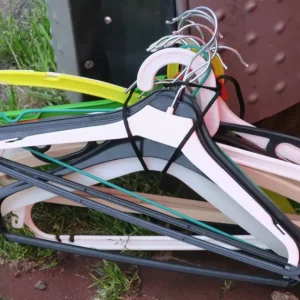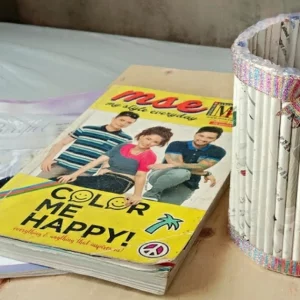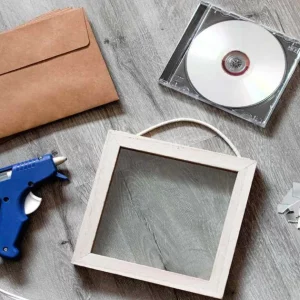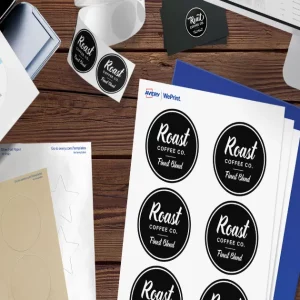If your dining chair cushion looks a bit worse for wear, don’t worry – you can easily reupholster it yourself! All you need is a cushion, some upholstery fabric, a needle and thread, and a few basic sewing skills.
In this article, Manymoon will show you how to reupholster a chair cushion. This is a relatively simple process that can be completed in a few hours.
Before You Begin Reupholstering your Chairs
It’s easy to get excited and dive into a project. Before purchasing your supplies, ensure that the chair you are reupholstering has enough value. Sometimes, it’s cheaper to reupholster dining chairs that aren’t structurally sound than to repair and reupholster them. Older furniture is usually more durable and well-built, making it worth restoring.
Select The Right Fabric
You should know the type of fabric you need and your budget before you shop. This will help you choose a fabric that best suits you and your lifestyle.

The suitable upholstery fabric will ensure that your chair seats last longer and provide comfort and style that compliments your home.
Each fabric is unique and has its benefits, limitations, and charm. These are some natural and synthetic fabrics options to consider when you’re looking to recover your dining room chairs.
- Cotton: This natural, breathable fabric is resistant to fading and abrasion. It is susceptible to staining, and it catches dirt and dust. This makes it safer for households without children or pets.
- Linen: This fabric is made from fibers from the flax plant. It’s a viral upholstery material that is also affordable. This fabric is soft, firm, smooth, and does not pill. It’s also antibacterial, abrasion-resistant, and easy to clean. This fabric is not able to withstand rough use.
- Wool: This environmentally-friendly fabric is durable and sturdy. It is insulating and resists staining and pilling. It is less popular than other upholstery materials, perhaps because it has a higher price tag.
- Leather: This is an elegant and comfortable option for upholstery. This fabric is durable and can withstand a lot of use. It is an intelligent fabric that can be used in homes with pets.
- Polyester: Polyester is a microfiber material that can be mixed with other fibers. It comes in a variety of colors and prints. Polyester is soft and comfortable while being easy to clean. Polyester is a high-tensile fabric, so it can stretch and feel a bit looser over time.
- Olefin: This popular synthetic fiber is easy to maintain and can withstand a lot of abuse (including roughhousing). It is made to feel and look like wool, but it is water-resistant. This fabric can be used indoors but is more commonly found on outdoor furniture.
Pro Tips For Furniture Upholstery
It’s easy to restore a dining room chair. However, if this is your first attempt at the task, it may be easier to work with straight chairs. These chairs are easier to reupholster. Once you’ve gained some experience, it will be easier to tackle more challenging upholstery projects.

- Remember that it is never too late for you to reposition a chair or other painting furniture. Take out the upholstery staples and retry.
- These are some other things to remember when recapping a chair.
- You can make your chair seats more comfortable by adding cotton batting to the fabric or foam underneath.
- To give your fabric a little more durability, you can add a layer of canvas to the top.
- Reupholstering old fabric can be done if the new fabric is darker in color than the original.
- You can cover the stapled side with a dust cover.
- When upholstering furniture with curvilinear edges, make pleats.
- Wrap your hammerhead with batting to create decorative accents such as grommets or nail heads. Secure it with an elastic band.
- Label each piece of fabric you take out so that the parts can be reassembled correctly.
- You can either film yourself or take photographs as you disassemble the furniture to help you plan your reassemble.
What you’ll need

Equipment / Tools
- Use a drill or a screwdriver
- Remover for staples
- Straight pins
- Fabric pencil or chalk
- Scissors
- Sewing machine
- Staple gun
Materials
- Upholstery fabric
- Welt cord (optional)
Instructions
1. Take The Seat Off
Turn the chair upside-down and remove the chair seat from its frame using a drill or screwdriver. You can make any repairs necessary to the wood parts of the chair, such as painting, refinishing, or tightening joints. Reattach the seat once everything is dry and not sticky.

Tip
You may encounter tack strips, a long piece of cardboard with tacks to hold the seat to chair frame. Instead of using screws, you can pry off the seat with a flat-head screwdriver.
2. Take Out The Old Fabric
Flip the seat. To remove old staples and excess fabric, use a stapler. Use needle-nose pliers to pull out stubborn staples. The old chair seat fabric can be saved. It will be necessary to use it for patterned fabric.
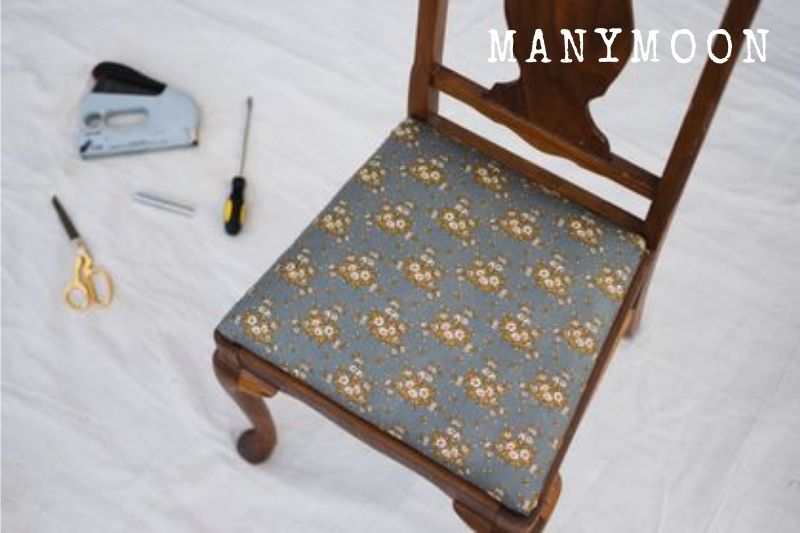
Tip
You can replace the padding if it is damaged or want a more comfortable seat. You can find it in most fabric and hobby shops.
3. Place Your Pattern In The Center
If the pattern on your new seat fabric is a rectangle, flip the seat upside down and place the new fabric over it. After pressing around the seat’s perimeter, align your pattern and mark the corners using straight pins.
Not necessary: You can skip this step if your fabric does not have a pattern.

4. Cut The New Cover For Your Seat
Place the new fabric right-side-up on the old cover. Take note of the pin locations and adjust as necessary by feeling under. Your straight pins should be aligned with the corners of your seat cover.
You can weigh down the old cover around the corners and trace the seat cover using a pencil or chalk. You can smoothen the edges of your traced cover with your hands, so it doesn’t get too small. If you aren’t confident with smoothing the edges, you can pin your old chair cover to your fabric before you start tracing.

The old seat cover can be removed, and the new one cut using the chalk or pencil lines as a guide. You can prevent fraying by using your sewing machine to zigzag around the edges of your fabric.
You can also fold the tape along the edges if you don’t wish to sew. If your fabric is wrinkled or creased, press it down.
5. Attach The Fabric To Your Seat
Place the new cover on top of the old one. Then, place the new chair cover right-side-up on top. Use pins to mark corners on patterned fabrics. Please make sure they align with the corners of your seat cushion.

Start at the top edge and staple once in the center. Continue with the bottom edge. Pull the fabric tighter before you staple. Continue to pull the fabric tight until you are finished.
Start by working on one side at a stretch. Continue to staple from the center until you have completed the entire side.
Keep pulling the fabric tight, and then smoothen the fabric from the middle. The corners should be left unstitched. Continue this process on all sides, except the corners.
6. Complete The Corners
Grab one corner of the cover, pull it toward the center of your seat cushion, and then staple it. The remaining corner fabric can be arranged into small pleats—finally, staple. Be sure to not staple over the screw holes. Continue with the remaining corners.

Tip
For a professional, finished look, add a welt cord. You can either buy decorative cording from fabric shops or make it yourself.
Apply the welt by placing it along the seat’s edge and then staple the lip (the flat side) of the welt. The cord should be visible only when the seat is turned over.
7. Reattach The Seat
Align the screws and place the seat on the frame. Turn the chair upside-down and tighten the screws to ensure that the seat does not fall off. Turn the chair upside down and tighten the screws until you have a secure seat. You don’t want the holes to be ripped.
FAQs
How can you reupholster an old chair without removing the fabric?
Remember that you can quickly recover a dining room chair with only one cushion cover. Lay the new fabric on top of the existing fabric. If you have more than one cushion cover, remove the top layer and draw out a few staples.
What glue are upholsterers using?
To make minor repairs to upholstery, you can use liquid fabric glue. Fabric glue is used to repair or seal seams. Upholstery repairs should be done with extra-strength glue.

How can you reupholster an unremovable chair seat?
- Use a small pry bar, flat screwdriver, and pliers to remove the old cover. …
- Place the new fabric on top of the dining chair cushion material. …
- Use a utility knife to trim the batting at the finished edges of the wood. …
- Secure the middle of each side in the same manner.
How can you conceal staples while reupholstering
Flat pieces of decorative trim fabric can be glued around stapled areas to hide staples beneath. Upholstery tacks can be used if most staples have been obscured and you are concerned about missing fabric sections.
Video
https://www.youtube.com/watch?v=_Ac9YBylm_o
Conclusion
You don’t need to pay hundreds of dollars for new seat cushions. You can do it yourself with a bit of knowledge and some basic sewing skills!
Thanks for reading, and if you found this helpful article, please share it with your friends.

